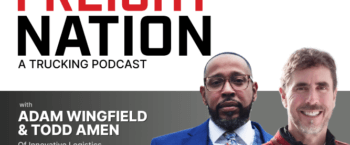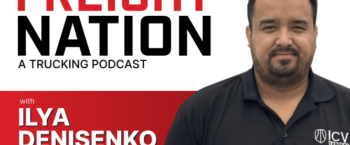Is Trucking Business Profitable? 6 Ways to Make More Money

You might have decided on a trucking career because you like the idea of being your own boss. Setting your own hours and being independent out on the road instead of sitting in an office is certainly appealing.
But is the trucking business profitable? On the surface, some statistics suggest it’s difficult to succeed in the trucking industry. The failure rate for startup trucking businesses typically ranges from 85-95%. However, looking at the industry overall, the percentage of companies that closed is more encouraging. In 2023, 88,000 of the 750,000 active motor carriers in the United States closed their doors, totaling a 12% closure rate.
The dramatic difference in closure rates could simply be due to the level of experience in the trucking industry. Startup trucking companies have a steep learning curve for how to make their trucking business profitable. But when you understand the factors that play into trucking business profitability, you can increase your chances for success.
Whether you’re an owner-operator or a truck driver for hire, following these six strategies can help you become a successful and profitable trucking business owner.
Average profit of a trucking company
One key to determining whether a trucking business is profitable is to understand the average trucking business profit and what’s an acceptable U.S. industry profit margin. While carrier revenue and profits vary depending on their unique situations, most truckers should aim for a 6%-8% profit.
Plan your profit by considering your gross annual income per truck, then determining your expenses (more on that later). You can then increase those margins by looking for higher-paying loads, reducing deadhead miles, and being aware of the competition in lanes.
What factors hurt profitability?
Though numerous factors determine how profitable a trucking business is, the two main factors to keep in mind are fixed and variable operating costs. Controlling labor costs is also essential for maintaining profitability, as it involves managing expenses related to wages, benefits, and driver retention programs.
Trucking business fixed costs
Fixed costs are those that stay the same each month, whether you’re on the road or parked at home. Regardless of how much you earn, fixed costs don’t change.
- Insurance. At the very minimum, you must carry primary auto liability (federal law) and general liability (state law) insurance. You will likely want to go above the basics and include coverage for physical damage, cargo, underinsured motorists, and rental reimbursement.
- Truck mortgage payments. If you have a loan on your truck, this is another fixed cost you must pay monthly.
- Licenses and permits. In addition to your commercial license, you’ll need funds for federal Department of Transportation (DOT) and Motor Carrier Authority numbers, Unified Carrier Registration, and an International Registration Plan tag. These licenses and permits may require regular updates, which could mean extra fees.
- Cell phone. Because you’re on the road often, you’ll need a way to communicate with everyone, from your family to your clients. Having a cell phone with unlimited calling and data is a basic necessity to work in the trucking industry.
- Professional fees. Most small businesses need to hire out regular help in specific areas like website development and hosting, accounting, and legal guidance.
Trucking business variable costs
Variable costs happen while you’re on the road and can differ based on where and how far you’re driving. They also affect cash flow, so it’s good to estimate on the higher end.
- Fuel. Gas prices change from state to state, city to city, and even from season to season. Even if you have a general idea of how much you’ll pay to haul cargo through Texas versus the Eastern Seaboard, count on fuel costs to fluctuate.
- Maintenance. Ongoing vehicle maintenance can vary widely by year, depending on what you need to keep your truck running smoothly. One month you might need a whole set of new tires, while another you might only need an oil change.
- Lodging. Like fuel costs, lodging expenses change based on region and season. Even if you can sleep in your truck, you may want to find a place to shower and rest, especially for long hauls.
- Food. Food (and coffee!) are must-haves. But food prices depend on the area, the type of food, and where you buy it. Fast food is cheaper than sit-down restaurants, as are snacks from the grocery store versus the gas station.
- Tolls. Depending on your lane, you’ll find that many U.S. interstates double as tolled turnpikes. In larger cities, “paid” toll lanes could mean less traffic, but that convenience might come at a cost — and an unpredictable one.
How to increase profitability when you own a trucking company
After tallying fixed and variable costs, you might be asking yourself again, “Is a trucking business profitable?” Successful trucking business owners know focusing on intelligent pricing strategies and making data-driven decisions are what make their trucking company profitable. Employing the following six strategies for running a successful trucking business can help make you one of them.
1. Lower your cost-per-mile.
The best way to do this is to know how much you’re spending, including both fixed and variable costs. Ways to lower your cost per mile include:
- Reducing fuel consumption by paying attention to your speed and driving habits
- Performing ongoing maintenance to prevent costly on-the-road breakdowns
- Planning routes to decrease out-of-route miles
2. Increase your rate-per-mile.
Charging shippers a higher percentage on top of your expenses is one way to increase payments. Also, picking up headhaul market loads and bringing them to backhaul markets could boost that rate-per-mile. Reducing deadhead miles by hauling LTLs would also help. Using a trusted load board known for higher-value loads is another way to increase your per-mile options.
3. Find high-paying truck loads.
You can build a great reputation and boost your revenue by taking on shipments that are more difficult to transport or require more skill or time. You can also target shippers who need freight moved immediately; urgent loads command premium rates. The best way to take advantage of high-paying loads is to be flexible and use load boards like Truckstop.
4. Increase “loaded” mileage.
Loaded miles are when you’re driving paid cargo. But sometimes, empty trailers happen. Try matching your routes with shipper demand and be willing to take backhauls to ensure your trailer is consistently full.
5. Reduce detention time.
There’s nothing more frustrating than waiting at a pick-up or delivery point longer than you planned. While shippers allow for a two-hour detention delay, sometimes it can stretch to three hours or more. That’s time you’re not getting paid. Worse, it might put you behind on other jobs. The best way to reduce detention time is to build extra space or detention pay into loading and unloading times or avoid taking loads from facilities or shippers known for long wait times.
6. Use factoring to get paid faster.
Factoring means you can sell your invoices from a job to a third-party financial company, also known as a factor. You walk away with the money right away (minus the factoring fee) rather than waiting the typical 30-90+ days it takes a broker to process your invoice. Meanwhile, the factoring company tracks down payments from the broker, so you don’t have to.
Book more high-paying loads.
The trucking industry can be lucrative, especially if you book higher-paying loads to maximize the amount of money you bring in. One sure way to do this is to use Truckstop’s Carrier Load Board to find quality loads at great rates. To get on board, call us or book a free demo to see how it works.

Find out how our platform gives you the visibility you need to get more done.
Get helpful content delivered to your inbox.
Schedule a demo.
Find out how our platform gives you the visibility you need to get more done.





